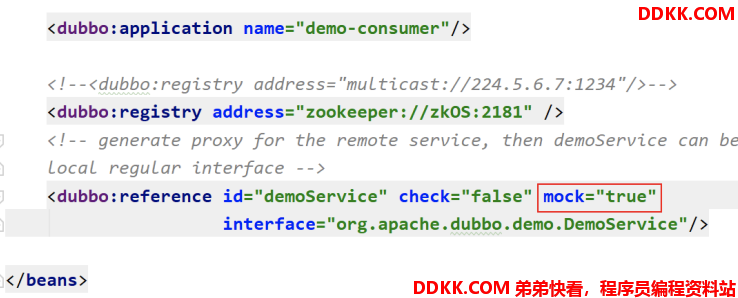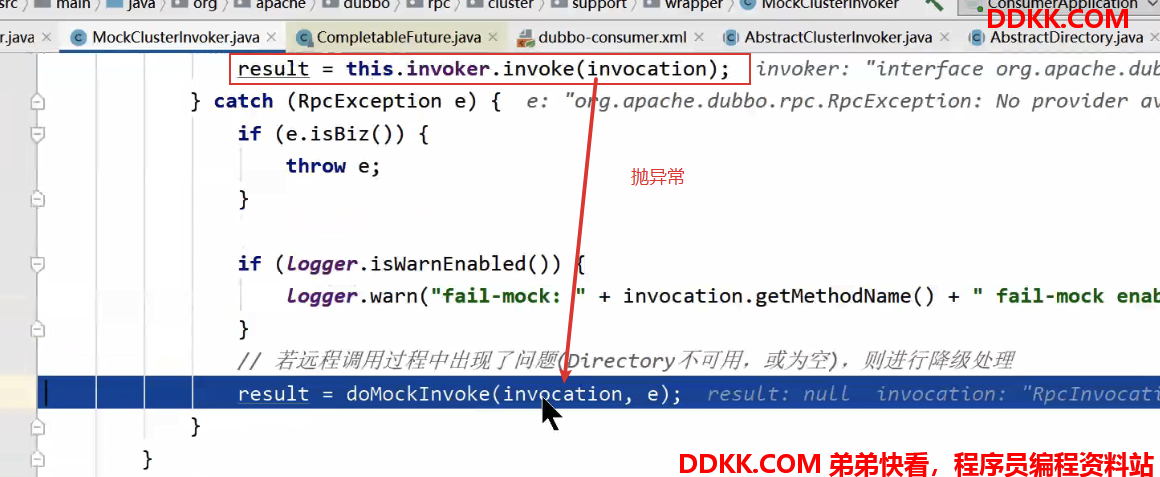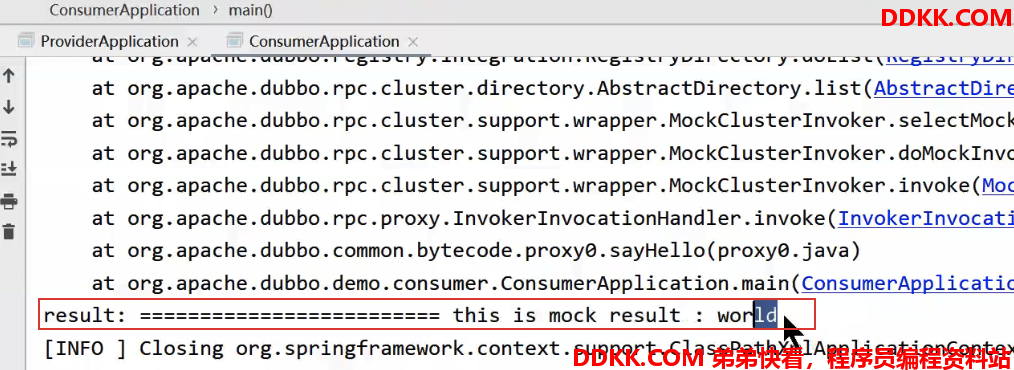服务降级
Dubbo 中常见的服务降级设置有四种:
- mock=”force:return null” (return 666也行,不一定非要null)表示消费方对该服务的方法调用直接强制性返回 null 值,不发起远程调用,即使远程的提供者没有出现问题。用来屏蔽不重要服务。
- mock=”fail:return null” 表示消费方对该服务的方法调用在失败后,再返回 null 值,不抛异常。用来容忍不重要服务不稳定时的影响。
- mock=”true”表示消费方对该服务的方法调用在失败后,会调用消费方定义的服务降级Mock 类实例的相应方法。而该 Mock 类的类名需要为“业务接口名+Mock”,且放在与接口相同的包中。
- mock=降级类的全限定性类名 与 mock=”true”功能类似,不同的是,该方式中的降级类名可以是任意名称,在任何包中。
1. 修改消费者端代码
为了演示服务降级,在调试之前首先修改消费者工程的代码。
(1) 定义 Mock 类
在org.apache.dubbo.demo 包中创建如下类(Mock类要和对应接口在同包下):
public class DemoServiceMock implements DemoService{
@Override
public String sayHello(String name) {
return "this is mock result : " + name;
}
}
(2) 修改配置文件

(3) 测试类
public class ConsumerApplication {
/**
* In order to make sure multicast registry works, need to specify '-Djava.net.preferIPv4Stack=true' before
* launch the application
*/
public static void main(String[] args) {
ClassPathXmlApplicationContext context = new ClassPathXmlApplicationContext("spring/dubbo-consumer.xml");
context.start();
DemoService demoService = context.getBean("demoService", DemoService.class);
String hello = demoService.sayHello("world");
System.out.println("result: ========================= " + hello);
}
}
2. 服务降级的调用
(1) forbidden 的值
我们前面跟服务订阅时,知道,一但注册中心的注册信息发生变化,会触发org.apache.dubbo.registry.integration.RegistryDirectory#notify方法:
//org.apache.dubbo.registry.integration.RegistryDirectory#notify
public synchronized void notify(List<URL> urls) {
...
// providers
// 处理category为providers的情况
List<URL> providerURLs = categoryUrls.getOrDefault(PROVIDERS_CATEGORY, Collections.emptyList());
refreshOverrideAndInvoker(providerURLs);
}
这里我们看providers处理:
//org.apache.dubbo.registry.integration.RegistryDirectory#refreshOverrideAndInvoker
private void refreshOverrideAndInvoker(List<URL> urls) {
// mock zookeeper://xxx?mock=return null
overrideDirectoryUrl();
// 更新invoker列表
refreshInvoker(urls);
}
//org.apache.dubbo.registry.integration.RegistryDirectory#refreshInvoker
private void refreshInvoker(List<URL> invokerUrls) {
Assert.notNull(invokerUrls, "invokerUrls should not be null");
// 若只有一个提供者url,且其protocol为empty,则说明当前没有提供者
// 则本次远程调用将被禁止
if (invokerUrls.size() == 1
&& invokerUrls.get(0) != null
&& EMPTY_PROTOCOL.equals(invokerUrls.get(0).getProtocol())) {
this.forbidden = true; // Forbid to access
this.invokers = Collections.emptyList();
routerChain.setInvokers(this.invokers);
destroyAllInvokers(); // Close all invokers
} else {
...
}
}
可以看到如果注册中心的服务提供者列表为空,forbidden将被赋值为 true,表示当前禁止进行远程访问。后面分析会用到这个属性。
(2) 找到服务降级代码
还是从消费者发起远程调用开始:
org.apache.dubbo.rpc.proxy.InvokerInvocationHandler#invoke
org.apache.dubbo.rpc.cluster.support.wrapper.MockClusterInvoker#invoke
//org.apache.dubbo.rpc.cluster.support.wrapper.MockClusterInvoker#invoke
public Result invoke(Invocation invocation) throws RpcException {
Result result = null;
// 获取mock属性值
String value = directory.getUrl().getMethodParameter(invocation.getMethodName(), MOCK_KEY, Boolean.FALSE.toString()).trim();
// 若没有指定mock属性,或其值为false,则没有降级功能
if (value.length() == 0 || value.equalsIgnoreCase("false")) {
//no mock 远程调用
result = this.invoker.invoke(invocation);
} else if (value.startsWith("force")) {
// 若mock的值以force开头,则进行强制降级处理
if (logger.isWarnEnabled()) {
logger.warn("force-mock: " + invocation.getMethodName() + " force-mock enabled , url : " + directory.getUrl());
}
//force:direct mock 降级处理
result = doMockInvoke(invocation, null);
} else {
// mock的值为其它情况
//fail-mock
try {
// 先进行远程调用
result = this.invoker.invoke(invocation);
} catch (RpcException e) {
if (e.isBiz()) {
throw e;
}
if (logger.isWarnEnabled()) {
logger.warn("fail-mock: " + invocation.getMethodName() + " fail-mock enabled , url : " + directory.getUrl(), e);
}
// 若远程调用过程中出现了问题(Directory不可用,或为空),则进行降级处理
result = doMockInvoke(invocation, e);
}
}
return result;
}
我们配的mock属性值是"true",所以此时会走最后一个else中的this.invoker.invoke(invocation),先继续跟远程调用,走
org.apache.dubbo.rpc.cluster.support.AbstractClusterInvoker#invoke方法:
//org.apache.dubbo.rpc.cluster.support.AbstractClusterInvoker#invoke
public Result invoke(final Invocation invocation) throws RpcException {
checkWhetherDestroyed();
// binding attachments into invocation.
Map<String, String> contextAttachments = RpcContext.getContext().getAttachments();
if (contextAttachments != null && contextAttachments.size() != 0) {
((RpcInvocation) invocation).addAttachments(contextAttachments);
}
// 服务路由
List<Invoker<T>> invokers = list(invocation);
// 获取负载均衡策略
LoadBalance loadbalance = initLoadBalance(invokers, invocation);
RpcUtils.attachInvocationIdIfAsync(getUrl(), invocation);
return doInvoke(invocation, invokers, loadbalance);
}
看list方法:
//org.apache.dubbo.rpc.cluster.support.AbstractClusterInvoker#list
protected List<Invoker<T>> list(Invocation invocation) throws RpcException {
return directory.list(invocation);
}
继续跟
org.apache.dubbo.rpc.cluster.directory.AbstractDirectory#list
org.apache.dubbo.rpc.cluster.directory.AbstractDirectory#doList
//org.apache.dubbo.registry.integration.RegistryDirectory#doList
public List<Invoker<T>> doList(Invocation invocation) {
if (forbidden) {
// 1. No service provider 2. Service providers are disabled
throw new RpcException(RpcException.FORBIDDEN_EXCEPTION, "No provider available from registry " +
getUrl().getAddress() + " for service " + getConsumerUrl().getServiceKey() + " on consumer " +
NetUtils.getLocalHost() + " use dubbo version " + Version.getVersion() +
", please check status of providers(disabled, not registered or in blacklist).");
}
...
return invokers == null ? Collections.emptyList() : invokers;
}
看到这里forbidden为true会抛出异常,然后直接跳回org.apache.dubbo.rpc.cluster.support.wrapper.MockClusterInvoker#invoke的异常处理:

继续跟doMockInvoke方法:
//org.apache.dubbo.rpc.cluster.support.wrapper.MockClusterInvoker#doMockInvoke
private Result doMockInvoke(Invocation invocation, RpcException e) {
Result result = null;
Invoker<T> minvoker;
List<Invoker<T>> mockInvokers = selectMockInvoker(invocation);
if (CollectionUtils.isEmpty(mockInvokers)) {
minvoker = (Invoker<T>) new MockInvoker(directory.getUrl(), directory.getInterface());
} else {
minvoker = mockInvokers.get(0);
}
try {
//主要跟这个方法
result = minvoker.invoke(invocation);
} catch (RpcException me) {
if (me.isBiz()) {
result = AsyncRpcResult.newDefaultAsyncResult(me.getCause(), invocation);
} else {
throw new RpcException(me.getCode(), getMockExceptionMessage(e, me), me.getCause());
}
} catch (Throwable me) {
throw new RpcException(getMockExceptionMessage(e, me), me.getCause());
}
return result;
}
跟org.apache.dubbo.rpc.support.MockInvoker#invoke:
//org.apache.dubbo.rpc.support.MockInvoker#invoke
public Result invoke(Invocation invocation) throws RpcException {
//获取 "方法名.mock" 的参数(即先处理方法级别的mock配置)
String mock = getUrl().getParameter(invocation.getMethodName() + "." + MOCK_KEY);
if (invocation instanceof RpcInvocation) {
((RpcInvocation) invocation).setInvoker(this);
}
if (StringUtils.isBlank(mock)) {
//尝试获取"mock"参数(方法级别配置为空,则获取接口级别)
mock = getUrl().getParameter(MOCK_KEY);
}
if (StringUtils.isBlank(mock)) {
throw new RpcException(new IllegalAccessException("mock can not be null. url :" + url));
}
// 规范化mock的值
mock = normalizeMock(URL.decode(mock));
...
}
先看normalizeMock方法,规范化mock的值:
//org.apache.dubbo.rpc.support.MockInvoker#normalizeMock
public static String normalizeMock(String mock) {
if (mock == null) {
return mock;
}
mock = mock.trim();
if (mock.length() == 0) {
return mock;
}
// 若mock为"return",则返回returnnull
if (RETURN_KEY.equalsIgnoreCase(mock)) {
return RETURN_PREFIX + "null";
}
// 若mock的值为true、default、fail、force,则统一返回default
// (isDefault方法判断是true,或default)
if (ConfigUtils.isDefault(mock) || "fail".equalsIgnoreCase(mock) || "force".equalsIgnoreCase(mock)) {
return "default";
}
// 若mock以fail:开头,则返回fail:后的内容
if (mock.startsWith(FAIL_PREFIX)) {
mock = mock.substring(FAIL_PREFIX.length()).trim();
}
// 若mock以force:开头,则返回force:后的内容
if (mock.startsWith(FORCE_PREFIX)) {
mock = mock.substring(FORCE_PREFIX.length()).trim();
}
// 若mock以return或throw开头
if (mock.startsWith(RETURN_PREFIX) || mock.startsWith(THROW_PREFIX)) {
//把符号替换为"
mock = mock.replace('', '"');
}
return mock;
}
继续回到org.apache.dubbo.rpc.support.MockInvoker#invoke:
//org.apache.dubbo.rpc.support.MockInvoker#invoke
public Result invoke(Invocation invocation) throws RpcException {
//获取 "方法名.mock" 的参数
String mock = getUrl().getParameter(invocation.getMethodName() + "." + MOCK_KEY);
if (invocation instanceof RpcInvocation) {
((RpcInvocation) invocation).setInvoker(this);
}
if (StringUtils.isBlank(mock)) {
//尝试获取"mock"参数
mock = getUrl().getParameter(MOCK_KEY);
}
if (StringUtils.isBlank(mock)) {
throw new RpcException(new IllegalAccessException("mock can not be null. url :" + url));
}
// 规范化mock的值
mock = normalizeMock(URL.decode(mock));
// 若mock以return开头
if (mock.startsWith(RETURN_PREFIX)) {
// mock取return后的内容
mock = mock.substring(RETURN_PREFIX.length()).trim();
try {
//获取此次远程调用的返回结果的类型
Type[] returnTypes = RpcUtils.getReturnTypes(invocation);
//将return后面的值 解析成对应的类型
Object value = parseMockValue(mock, returnTypes);
return AsyncRpcResult.newDefaultAsyncResult(value, invocation);
} catch (Exception ew) {
throw new RpcException("mock return invoke error. method :" + invocation.getMethodName()
+ ", mock:" + mock + ", url: " + url, ew);
}
} else if (mock.startsWith(THROW_PREFIX)) {
//以throw开头,则抛异常
mock = mock.substring(THROW_PREFIX.length()).trim();
if (StringUtils.isBlank(mock)) {
throw new RpcException("mocked exception for service degradation.");
} else {
// user customized class
Throwable t = getThrowable(mock);
throw new RpcException(RpcException.BIZ_EXCEPTION, t);
}
} else {
//impl mock
//重点在这
try {
// 使用本地mock类构建成一个invoker
Invoker<T> invoker = getInvoker(mock);
return invoker.invoke(invocation);
} catch (Throwable t) {
throw new RpcException("Failed to create mock implementation class " + mock, t);
}
}
}
看到这个方法处理了三种情况:
- 若mock以return开头,则获取return后的内容转换成方法返回值对应的类型,返回
- 若mock以throw开头,则抛异常
- 使用本地mock类构建成invoker进行调用
重点看第三种方式,看getInvoker方法:
//org.apache.dubbo.rpc.support.MockInvoker#getInvoker
private Invoker<T> getInvoker(String mockService) {
Invoker<T> invoker = (Invoker<T>) MOCK_MAP.get(mockService);
if (invoker != null) {
return invoker;
}
// 获取业务接口
Class<T> serviceType = (Class<T>) ReflectUtils.forName(url.getServiceInterface());
// 获取本地mock类实例
T mockObject = (T) getMockObject(mockService, serviceType);
// 将mock类实例构建为invoker
invoker = PROXY_FACTORY.getInvoker(mockObject, serviceType, url);
if (MOCK_MAP.size() < 10000) {
MOCK_MAP.put(mockService, invoker);
}
return invoker;
}
看getMockObject:
//org.apache.dubbo.rpc.support.MockInvoker#getMockObject
public static Object getMockObject(String mockService, Class serviceType) {
//如果标签中mock配的是true,此时这里mockService应该是default
if (ConfigUtils.isDefault(mockService)) {
// 业务接口的全限定性类名后添加Mock,形成Mock类名
mockService = serviceType.getName() + "Mock";
}
// 加载指定的类
Class<?> mockClass = ReflectUtils.forName(mockService);
if (!serviceType.isAssignableFrom(mockClass)) {
throw new IllegalStateException("The mock class " + mockClass.getName() +
" not implement interface " + serviceType.getName());
}
try {
// 创建mock类实例
return mockClass.newInstance();
} catch (InstantiationException e) {
throw new IllegalStateException("No default constructor from mock class " + mockClass.getName(), e);
} catch (IllegalAccessException e) {
throw new IllegalStateException(e);
}
}
